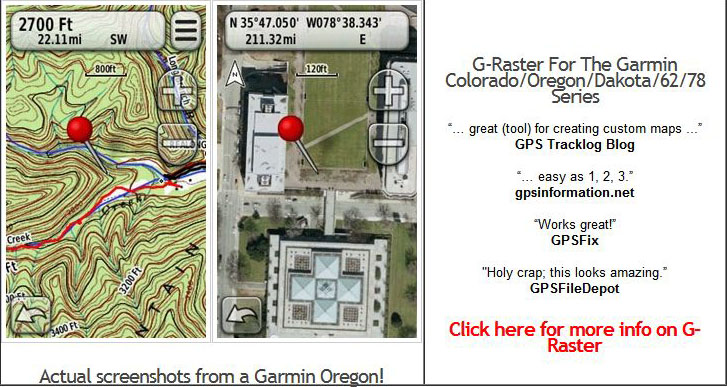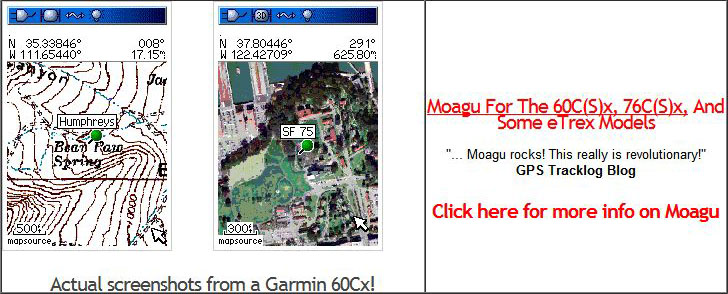Fromat Sd Card Through Garmin Nuvi Fromat Sd Card Through Garmin Nuvi Insert a Disk and Try Again
The new Garmin handheld GPS units with the "10" designation now offer removable microSD cards for map storage. Among the models with this capability are:
| GPSmap 60Cx | GPSmap 60CSx | GPSmap 76Cx | GPSmap 76CSx |
| eTrex Venture Cs | eTrex Vista Cx | eTrex Fable Cx | eTrex Vista HCx |
| eTrex Fable HCx | Astro Canis familiaris Tracking | Rino 520 HCx | Rino 530 HCx |
The first 4 are very similar in their electronics and capabilities; I own the commencement on the list (the 60Cx), and it'south fantastic! The SirfStarIII chipset allows fast position acquisition with incredible sensitivity – I can get fixes in heavy tree encompass and mountainous terrain that gave my old Garmin eMap fits. The HCx models also use the SirfStar 3 chipset. While not geodetic-quality, if you apply any of the SirfStarIII units with some care it'south possible to achieve 1-2 meter existent-fourth dimension positional accuracy repeatably. And the microSD (aka TransFlash) memory cards allow for lots of room for Garmin'southward uploadable maps, similar the Garmin USA Topo or City Navigator serial. I've seen 1 GB microSD cards for less than 15 dollars, and Garmin says that their units will support 2 GB cards (but not SanDisk Ultra II cards). Added 6/22/2009: Contempo hardware upgrades to some Garmin units may have increased this to 4 GB, just there are apparently issues with some cards. But there are 2 drawbacks to these big-capacity microSD cards:
ane. It appears as though the USB connection used for uploading map data is USB 1.one at 12 Mbps, not USB two.0 at 480 Mbps. Maximum transfer speed for a standard microSD card is on the order of lxxx Mbps, well below USB 1.ane'southward speed. While non a big deal for the default 64 MB microSD card that comes with about of these units, filling up a 512 MB carte du jour using USB one.ane tin be fourth dimension-consuming. For case, I have a set of 1300 MetroGuide and Topo maps that cover much of the western US and take up about 470 MB of space. Uploading these into my Garmin with a 512 MB card, even with USB, takes about 50 minutes: 10 minutes just to put together the map set index and data, and forty minutes to upload the data to the GPS unit. If yous were to upload a full two GB of data, information technology could take as longer than two hours! The read-write speed of a microSD card is 80 Mbps, which is most half-dozen.five fourth dimension faster than USB 1.one, but about 1/9th the speed of USB ii.0, so it could do good from a USB 2.0 connection.
ii. There's a limit of 2025 individual maps in a map set. For some map sets, like MetroGuide, y'all can embrace the whole Usa easily without coming anywhere close to this limit. Only combine that with a set of Garmin Topo maps, or some other map sets, and y'all could hit that limit easily. 2/08/2008: If you utilise a card reader, you tin load more than 2025 individual maps, only your Garmin may not be able to read them all, leaving gaps in the coverage.
In that location's an piece of cake and adequately cheap solution to the upload speed problem. When you lot purchase a new microSD card, it usually comes with an adapter that allows you to use it every bit a standard-size SD card (Garmin doesn't supply 1 with its units, though). Y'all can buy a USB 2.0 menu reader capable of reading/writing to such a menu for less than $x shipped; just make sure it's fully USB ii.0 uniform, and tin take SD cards. If you lot don't already have a large-capacity microSD menu, yous can get a 2 GB carte du jour from Amazon forth with a compact USB 2.0 card reader for less than $25:
If you plug the microSD menu into a card reader, Garmin's MapSource software volition recognize the bill of fare reader equally a legitimate destination for uploading, and let you to send mapsets to the card at a speed limited only past the USB 2.0 port and the read/write speed of the microSD card. In my example, using such a card reader to upload data cuts the total time, including indexing and creating the map set, from 50 minutes down to less than 15 minutes – nice!
But in one case you've created and uploaded such a mapset, and y'all want to use it again in the future, at that place'due south an even faster mode to get it onto your microSD bill of fare than using MapSource. The microSD card will bear witness up every bit a removable drive in My Computer in Windows; open this bulldoze and yous'll encounter i folder called "garmin". Open that folder, and it will contain a single file called "gmapsupp.img"; this is the file that contains all of the combined map information that's been uploaded. You tin can re-create this file to your hard drive, and salve it for future employ. The next time y'all want to use this map set, simply open up that "garmin" folder again on your microSD bill of fare, delete the old gmapsupp.img file, and copy the gmapsupp.img map set file you desire to employ into the "garmin" folder. When yous put that microSD carte du jour into your Garmin and plow it on, it volition take a few seconds for it to index the data, but then you'll be set up to utilize that map set up data. Copying over the gmapsupp.img file I created in a higher place from my hard bulldoze to the microSD card took only virtually four minutes, because in that location was no need to run MapSource to index and get together the map set. Double squeamish!
Only you can also employ this capability to increase the total number of maps stored on your microSD menu to more than the 2025 map limit, although you'll all the same only take access to a max of 2025 at any one fourth dimension. First, break upward the maps into multiple sets, each with less than 2025 maps. Upload ane set up to the microSD card, then open upwards the microSD carte du jour and alter that mapset's name to something else other than gmapsupp.img. Upload some other prepare, and alter its name to something else also. Keep doing this until you run out of mapsets, or out of infinite on the microSD card. To enable your Garmin to use and display and of those mapsets, change the proper noun of the mapset you want to use to gmapsupp.img. You tin access these files to change their names either through the SD carte reader, or by putting your Garmin into USB Mass Storage mode (available from the Interface screen in the Setup department) while it's hooked up to the estimator through the USB connectedness to make the Garmin act like an SD card reader.
1 caveat: I've tried this only on Garmin map data that doesn't require an unlock code. It should work on lockable map sets too, every bit long every bit you upload them to the unit of measurement they're unlocked for, but I can't swear to that; let me know if there's a problem with those.
All in all, handling the Garmin data in the microSD carte du jour this manner could save you lots of time and effort.
Finally, if you haven't updated your unit's firmware recently, you should practice so. The original units had a express retentivity capacity for saving track data, simply the updated software allows you to salvage rail data directly to the microSD menu, so you're only limited by the amount of free memory bachelor on the card. You lot can set up this option in the Tracks => Setup Information Menu Setup section; check the box next to "Log Rail To Data Card". Tracks logged here will *not* show up either on the display, or in the Track list, and yous can't download them using EasyGPS or other standard GPS utilities. They're saved equally engagement-stamped GPX files on the microSD card, so yous'll have to open up upwards the microSD card straight from the computer and copy them over; either plug the microSD menu into a menu reader, or put your Garmin into USB mass storage manner to access these files, re-create them over to your computer, then delete them on the microSD card to costless up space for new tracks.



Source: https://freegeographytools.com/2007/garmin-microsd-card-tricks
0 Response to "Fromat Sd Card Through Garmin Nuvi Fromat Sd Card Through Garmin Nuvi Insert a Disk and Try Again"
Postar um comentário